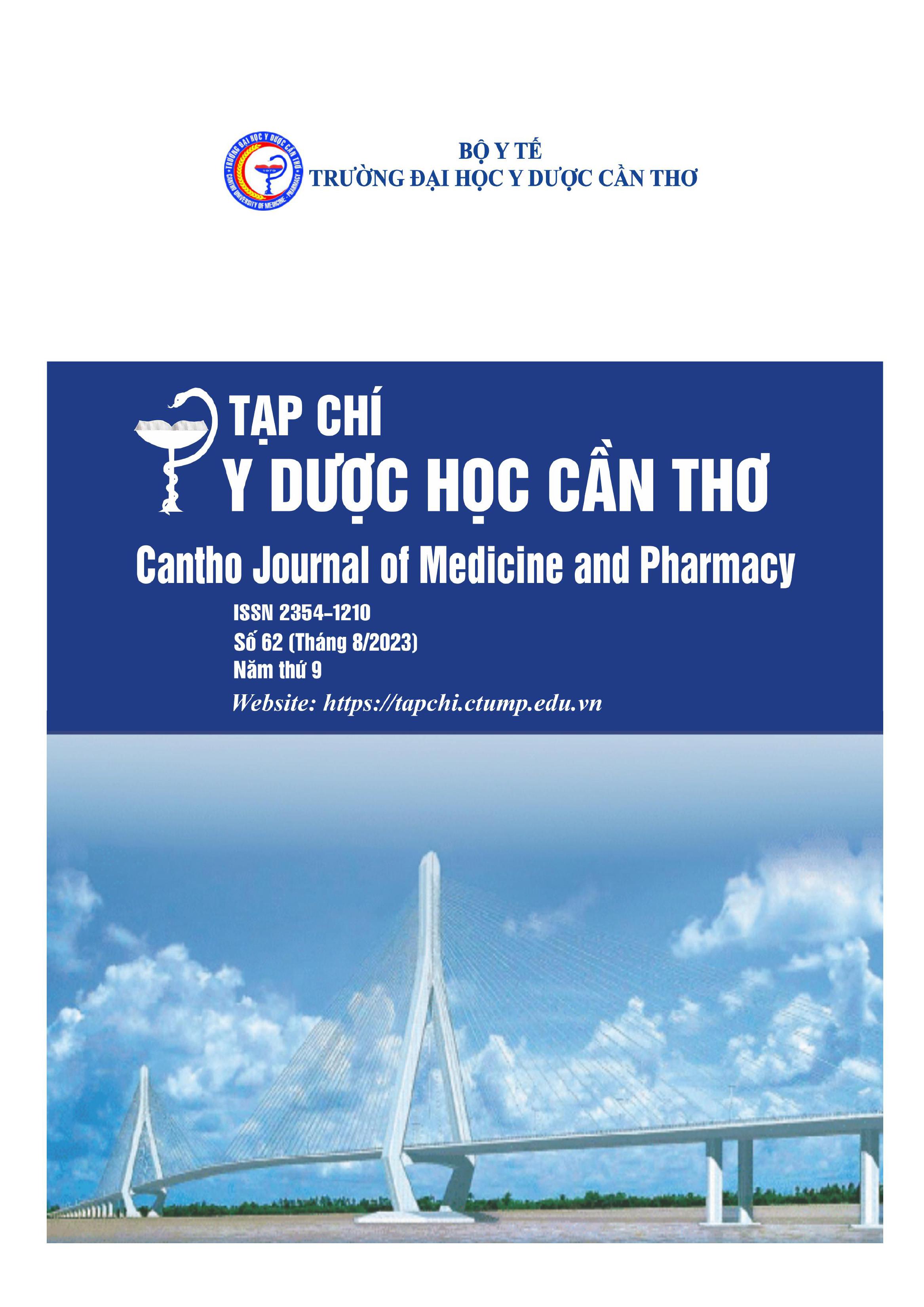SURVEY ON CLINICAL, SUBCLINICAL CHARACTERISTICS AND ASSESSMENT OF TREATMENT RESULTS OF STAPHYLOCOCCUS AUREUS PNEUMONIA
Main Article Content
Abstract
Background: Despite advancements in diagnosis and treatment, Staphylococcus aureus pneumonia, whether of nosocomial or community origin, continues to be a severe clinical scenario with high mortality. Objectives: To survey of clinical, subclinical features and treatment outcomes in patients with Staphylococcus aureus pneumonia. Materials and methods: A cross-sectional descriptive study conducted in 65 patients with Staphylocccus aureus pneumonia. Results: clinical and subclinical characteristics included: high fever (75%), respiratory failure (70.8%), multilobar infiltrate (75.4%). The resistance characteristics of S. aureus were oxacillin 82.8%, clindamycin 86.2%, levofloxacin 60.9%, ciprofloxacin 60..% và gentamycin 72.7%. S. aureus was susceptible with vancomycin 100% and linezolid 98.5%. 52.3% of patients recovered and 47.7% of patients failed treatment, respectively. Conclusions: Pneumonia caused by S. aureus has a severe clinical condition, multilobar infiltration, and high rate of failure treatment.
Article Details
Keywords
Pneumonia, Staphylococcus aureus, treatment results
References
2. Haque N.Z., Arshad S., Peyrani P., Ford K.D., Perri M.B., et al. Analysis of pathogen and host factors related to clinical outcomes in patients with hospital-acquired pneumonia due to methicillin-resistant Staphylococcus aureus. J Clin Microbiol. 2012. 50(5), 1640-1644, doi: 10.1128/JCM.06701-11.
3. Gillet Y., Vanhems P., Lina G., Bes M., Vandenesch F. et al. Factors predicting mortality in necrotizing community-acquired pneumonia caused by Staphylococcus aureus containing PantonValentine leukocidin. Clinical Infectious Diseases. 2007. 45(3), 315-321, doi: 10.1086/519263.
4. Gillet Y., Issartel B., Vanhems P., Fournet J.C., Lina G. et al. Association between Staphylococcus aureus strains carrying gene for Panton-Valentine leukocidin and highly lethal necrotising pneumonia in young immunocompetent patients. Lancet. 2002. 359(9308), 753-759, doi: 10.1016/S0140-6736(02)07877-7.
5. Nguyễn Thanh Bảo, Cao Minh Nga, Trần Thị Thanh Nga, Vũ Thị Kim Cương, Nguyễn Sử Minh Tuyết, Vũ Bảo Châu, và cộng sự. Chọn lưa kháng sinh ban đầu trong điều trị nhiễm khuẩn bệnh viện tại một số bệnh viện TP HCM. Y học Thành phố Hồ Chí Minh, chuyên đề Nội Khoa II. 2012. 16(1), 206-214.
6. Tạ Thị Diệu Ngân. Nghiên cứu đặc điểm lâm sàng, cận lâm sàng và căn nguyên của viêm phổi mắc phải tại cộng đồng. Luận án Tiến sĩ Y khoa, Trường Đại học Y Hà Nội. 2016.
7. Micek S.T., Reichley R.M., Kollef M.H.. Health care-associated pneumonia (HCAP): empiric antibiotics targeting methicillin-resistant Staphylococcus aureus (MRSA) and Pseudomonas aeruginosa predict optimal outcome. Medicine (Baltimore). 2011. 90(6), 390-395, doi:
10.1097/MD.0b013e318239cf0a.
8. Shimazaki N., Hayashi H., Umeda K., Aoyama T., Iida H., et al. Clinical factors affecting the efficacy of vancomycin in methicillin-resistant Staphylococcus aureus pneumonia. Int J Clin Pharmacol Ther. 2010. 48(8), 534-41, doi: 10.5414/cpp48534.
9. Tadros M., Williams V., Coleman B. L., McGeer A. J., Haider S. et al. Epidemiology and outcome of pneumonia caused by methicillin-resistant Staphylococcus aureus (MRSA) in Canadian hospitals. PLoS One. 2013. 8(9), e75171, doi: 10.1371/journal.pone.0075171.
10. Huang F., Shen T., Hai X., Xiu H., Zhang K. et al. Clinical characteristics of and risk factors for secondary bloodstream infection after pneumonia among patients infected with methicillin-resistant Staphylococcus aureus. Heliyon. 2022. 8(12), e11978, doi: 10.1016/j.heliyon.2022.e11978.
11. Shorr A.F., Myers D.E., Huang D.B., Nathanson B.H., Emons M.F., et al. A risk score for identifying methicillin-resistant Staphylococcus aureus in patients presenting to the hospital with pneumonia. BMC Infect Dis. 2013. 13, 268, doi: 10.1186/1471-2334-13-268.
12. Li H.T., Zhang T.T., Huang J., Zhou Y.Q., Zhu J.X., et al. Factors associated with the outcome of life-threatening necrotizing pneumonia due to community-acquired Staphylococcus aureus in adult and adolescent patients. Respiration. 2011. 81(6), 448-460, doi: 10.1159/000319557.
13. Self W.H., Wunderink R.G., Williams D.J., Zhu Y., Anderson E.J., et al. Staphylococcus aureus Community-acquired Pneumonia: Prevalence, Clinical Characteristics, and Outcomes. Clin Infect Dis. 2016. 63(3), 300-309, doi: 10.1093/cid/ciw300.
14. Trần Đỗ Hùng và Phạm Thành Suôl. Nghiên cứu sự đề kháng kháng sinh và sinh men BLactamase phổ rộng của S. aureus được phân lập từ những bệnh phẩm tại Bệnh viên Đa Khoa Trung Ương Cần Thơ. Tạp Chí Y học Việt Nam. 2016. 429(1), 52-57.
15. De la Calle C., Morata L., Cobos-Trigueros N., Martinez J.A., Cardozo C. et al. Staphylococcus aureus bacteremic pneumonia. Eur J Clin Microbiol Infect Dis. 2016. 35(3), 497-502, doi:
10.1007/s10096-015-2566-8.


